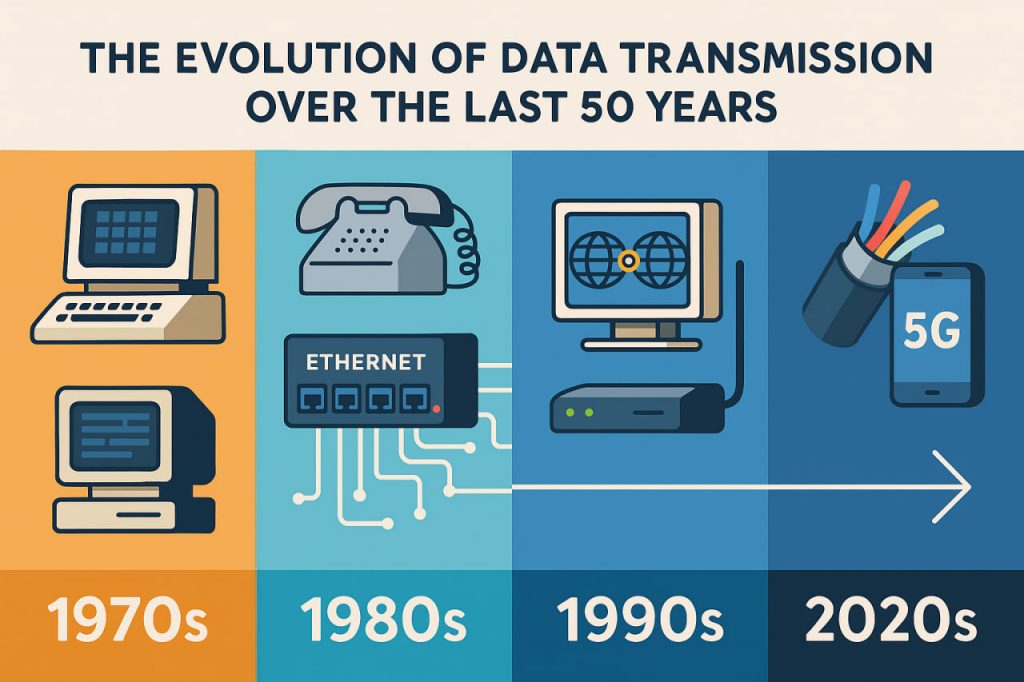In just half a century, the world has gone from slow, analog communications to lightning-fast global connectivity. The evolution of data transmission technologies has revolutionized how we share information, conduct business, and experience daily life. From copper wires and dial-up modems to fiber optics and 5G, the progress is staggering.
1970s–1980s: The Dawn of Digital Transmission
The 1970s marked a shift from analog to digital data. Early computers communicated using telephone lines and modems, which converted digital signals into sounds (and back). The speeds were slow—ranging from 300 to 2,400 bits per second (bps)—but it was a revolutionary start.
During the 1980s, packet switching emerged as a new method of transmitting data. Instead of sending entire messages in one block, information was broken into packets that could take different routes and be reassembled at the destination. This technology laid the foundation for the internet.
1990s: The Internet Goes Public
The 1990s saw the rise of dial-up internet, allowing personal computers to connect to the World Wide Web. Transmission speeds improved to 28.8 kbps and later 56 kbps, but users had to choose between using the phone or the internet.
In parallel, corporate and academic networks began adopting ISDN, T1, and Ethernet connections for faster speeds and reliability. Email, web browsing, and file sharing became practical for the first time.
2000s: Broadband and Mobile Networks
By the early 2000s, broadband (DSL and cable) replaced dial-up, offering speeds of several megabits per second. This allowed for streaming, online gaming, and cloud computing to take off.
At the same time, Wi-Fi became widespread, freeing data transmission from physical cables. Mobile networks evolved from 2G (good for SMS and calls) to 3G, enabling mobile internet access and multimedia messaging.
2010s: Fiber Optics, 4G, and Cloud Explosion
The 2010s marked the arrival of fiber-optic technology, using light signals to transmit data at gigabit speeds. This dramatically boosted the internet’s capacity and enabled HD video, real-time communication, and large-scale cloud services.
4G LTE mobile networks brought high-speed internet to smartphones, powering the rise of mobile apps, video calls, and streaming platforms. Meanwhile, data centers grew rapidly to handle the explosion in cloud-based computing.
2020s: 5G, Edge Computing, and Beyond
Today’s cutting-edge technologies like 5G provide ultra-low latency and speeds up to 10 Gbps, making real-time remote surgery, autonomous vehicles, and smart cities possible. At the same time, edge computing is reducing reliance on central servers by processing data closer to where it’s generated.
Satellite internet projects like Starlink are expanding access to remote regions, while quantum communication is being explored as a potential future replacement for classical data transmission.
Key Milestones in Data Transmission
- 1971 – First email sent.
- 1983 – TCP/IP protocol adopted for the ARPANET (birth of the Internet).
- 1991 – Launch of the World Wide Web.
- 2007 – Introduction of the iPhone and mobile broadband revolution.
- 2020s – Rollout of global 5G networks and low-earth orbit satellite internet.
Glossary
- Modem – A device that converts digital signals into analog and vice versa.
- Packet switching – A method of sending data by breaking it into smaller packets.
- Broadband – High-speed internet access through cable or DSL.
- Fiber optics – Technology that uses light to transmit data through glass fibers.
- Edge computing – Processing data near its source instead of relying on centralized data centers.


